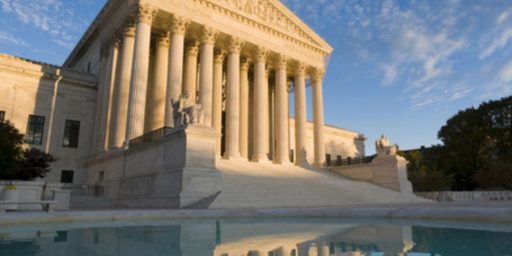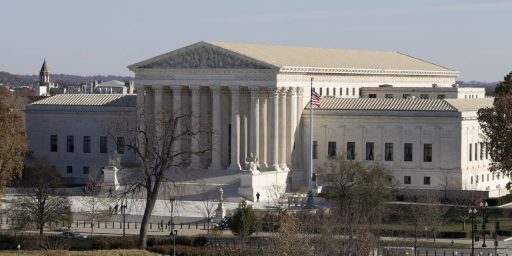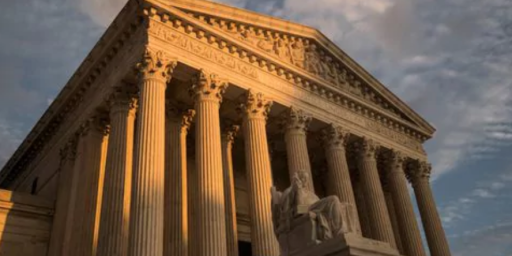Supreme Court To Hear Case Involving Employees Rights And Public Employee Unions
The Supreme Court has agreed to hear a major case about public employee unions that could go a long way toward restraining their power.
The day after it handed down its last opinions, the Supreme Court announced that it had accepted several new cases for review in the upcoming term, including a case involving public employee unions that is likely to be the focus of much attention from both sides of the political aisle:
The Supreme Court said Tuesday that it will consider next term whether the rights of government workers are violated when they are compelled to pay fees to unions they do not want to join.
The justices will consider a case from a group of California teachers who say paying fees violates their free speech rights when they disagree with the positions the unions take.
The Supreme Court nearly 40 years ago said that states may allow unions to collect fees from non-members to pay for collective bargaining costs, but not for the political spending the unions do.
But conservatives on the court have expressed doubt about the precedent, and came a vote short last year of overturning it. Instead, the court decided a case from Illinois on narrower grounds.
The case is Friedrichs v. California Teachers Association.
Lyle Denniston lays out the issues in the case, and what the Court will be dealing with when it returns:
It has been clear, since the Court’s ruling exactly one year ago in Harris v. Quinn, that a majority of the Court would welcome a plea to undo the first precedent extending “agency shop” rules to the public sector — Abood v. Detroit Education Association. That four-decade-old precedent was roundly criticized in the lead opinion in Harris, but the opinion stopped short of saying that the ruling should be overturned.
That is the key issue in the new case, Friedrichs v. California Teachers Association. In fact, that case from its beginning was intended as a direct challenge to the Abood decision, and two lower courts decided it quickly on that premise, sending it on toward the Supreme Court.
The new case will be decided in the Court’s new Term, which opens in October. The case is likely to come up for a hearing in December or January.
A final ruling may emerge next year in the midst of a presidential election campaign in which the role of labor unions in American life could be a visible issue. Wisconsin’s Republican governor, Scott Walker, is expected to seek the GOP nomination for the White House after building his public reputation largely out of a showdown with public employee unions in his state.
At the center of the test case before the Court is a practice that labor unions consider essential to their very survival: the ability to draw some financial support from all workers in a unit covered by a union contract, whether they belong to the union or not. Because unions have a binding legal duty to act in the interest of all workers included in the unit, the labor organizations want to collect fees even from “free riders,” as they call non-union workers.
Under Supreme Court rulings going back at least to 1944, companies in the private sector may be required to engage in collective bargaining with a union representing all of the workers in a bargaining unit. If the workplace is not a “union shop,” in which all workers must belong to the union in order to keep their jobs, it can still be an “agency shop.”
Under an “agency shop,” all workers pay union fees. But two rulings by the Court in 1956 and 1961 declared that workers can only be required to pay an amount to support union activities related to collective bargaining, and not for union political activity to which some non-union workers may object.
In the Abood decision in 1977, the Court for the first time ruled that the “agency shop” can be enforced for government workers, too, provided that the fees non-union members paid are related directly to union expenses for collective bargaining, administering the union contract with the employer, or internal grievance procedures.
Even though unions in the public sector attempt to influence government policy-making, to protect the interests of those they represent, the Court declared that that activity is not to be treated as political for purposes of the amount of “agency shop” fees to non-members.
That rationale for the Abood decision is the direct target of the new Friedrichs case. The lawyers who developed that case contend that everything a public-employee union does is an attempt to influence public policy, so non-union members should not have to pay any fees to support the union, if they have a personal objection.
Thus, the case seeks the overruling of the 1977 precedent, to establish a new ban on the “agency shop” throughout the public sector.
A second issue in the case — added in case the Court chose not to overrule Abood — is whether it is unconstitutional to require non-union public employees to pay fees to support union collective bargaining activity unless they expressly opt out. The lawyers for the teachers argue that such employees should be charged fees only if they opt in, explicitly declaring their willingness to pay their share of those expense-related fees.
On the left, of course, the case is being characterized as another case that threatens to “gut” public employee unions. In reality, though, what we’re actually looking at here is just the next step after the Court’s decision in a case out of Illinois that attempted to require mandatory unionization of home healthcare workers tied unto the state’s Medicaid system. In that case, Harris v. Quinn, the Court invalidated the rule but did not go as far as some thought they might and attack the precedent in Abood itself. This time around, it seems as though it is going to be difficult if not impossible for the Justices to avoid dealing with that case and the fundamental issues that it presents. Given the majority in Harris, it would seem that the odds are quite good that the Court will rule against the union here, which is no doubt the reason that public employee unions and their allies are seemingly so unnerved just by the fact that the Court has accepted the case for review at all.
As I’ve noted before, there are serious First Amendment issues involved in cases like this, not only in the manner in which a person in the Plaintiff’s position in this case are forced to join a union in order to hold the job they went to college for to begin with, but also because of the issue of the compelled subsidization of political speech via union dues. Even conceding the point that, on some level, an employee in the position of people like this Plaintiff would be something of a free rider of they were allowed to benefit from the terms negotiated by the union without contributing to the costs of collective bargaining, that alone is not a sufficient answer to problem created when union dues are used for purposes not related to bargaining. It’s fairly well-settled that people cannot be compelled to speak on political matters as a condition of employment, and yet, even under a system where the dues being charged are reduced to cover only “non-political” activities, the fact remains that the fungible nature of money means that they dues that are paid ultimately do help subsidize speech that a member may disagree with. One solution to that, obviously, would be strict requirements that unions limit their activities to collective bargaining, but that raises First Amendment problems of its own and would be largely unenforceable. In any case, the problem of compelled speech is one that was at the center of Harris v. Quinn and it will likely play a role in this case as well.
Beyond the legal issues, there are also legitimate questions about the entire idea of public employee unions that have been raised in the past, not only by conservatives, but also by President Franklin D. Roosevelt himself:
Roosevelt’s reign certainly was the bright dawn of modern unionism. The legal and administrative paths that led to 35% of the nation’s workforce eventually unionizing by a mid-1950s peak were laid by Roosevelt.
But only for the private sector. Roosevelt openly opposed bargaining rights for government unions.
“The process of collective bargaining, as usually understood, cannot be transplanted into the public service,” Roosevelt wrote in 1937 to the National Federation of Federal Employees. Yes, public workers may demand fair treatment, wrote Roosevelt. But, he wrote, “I want to emphasize my conviction that militant tactics have no place” in the public sector. “A strike of public employees manifests nothing less than an intent on their part to prevent or obstruct the operations of Government.”
And if you’re the kind of guy who capitalizes “government,” woe betide such obstructionists.
Roosevelt wasn’t alone. It was orthodoxy among Democrats through the ’50s that unions didn’t belong in government work. Things began changing when, in 1959, Wisconsin’s then-Gov. Gaylord Nelson signed collective bargaining into law for state workers. Other states followed, and gradually, municipal workers and teachers were unionized, too.
These are policy matters beyond the purview of the Court, of course, but they go to the reason why this case, and Harris, are important and why they are different from issues surrounding unions in the private workplace. Public employee unions are a powerful force, and not necessarily a beneficial one for either their members or for taxpayers. To the extent that there power can be restrained, perhaps we will all benefit.







For instance, when the union rep stands with the employee that a manager is trying to fire, and ensures that, yes, management has in fact documented performance reasons and isn’t just firing someone for something spurious… That is clearly an attempt to influence public policy.
If they were actually powerful, we would not be having the pension crisises across the country — they would have ensured that the government’s were contributing the appropriate amount into the pension plan.
I am still aghast that efforts to cut pension payments have not resulted in unions going out on strike, demanding either the appropriate contributions into the pensions, or that the deferred compensation no longer be deferred because the employer was acting in bad faith.
The Republican war on the middle class continues apace.
Well obviously their membership thinks they are beneficial to them. As for taxpayers, they don’t enter the equation and there’s no reason they should.
The questions Stephen Bainbridge asks about the validity or legitimacy of public employee unions can, and have, been raised about all unions.
To call them pedantic would be too kind.
@C. Clavin:
This is another classic example of Republicans not liking the results of their policy prescriptions. Weaken the unions, and thus the middle class…then whine about the new normal of the economy when there is no longer any middle-class-generated demand. I’m just never sure if Republicans are too stupid to make the connection…or think that everyone is so stupid they won’t see what they are up to.
There is a reason the Koch’s gave Walker tens of millions of dollars…and it ain’t because of First Amendment issues.
Weakening unions…making it harder for certain groups of people to vote…I guess when your voter base is shrinking, you do whatever you can to get as many votes as you can…
And once again libertarian Doug proudly fights for the rights of the powerful to fully exploit those weaker than themselves, in this case by eliminating collective bargaining.
@C. Clavin: At one time Eastern Airlines was a huge, powerful company (“too big to fail”?). I knew a man who worked for them and always said that their union could not just keep asking for more and more at contract time. They were already way above most other airlines and other companies in terms of pay and benefits, especially since a lot of their jobs did not require any college. College students worked part time for them, cleaning out the cabins. Even they were paid way above minimum wage to push a vacuum cleaner and put magazines up. Well, the roof collapsed when the government de-regulated the airline industry. Eastern lost their monopoly on the gates. The flight was over. The “Wings of Man” were grounded.
There is a lesson there somewhere. Probably several.
@Tyrell:
Yes…there is a lesson there…de-regulation is a critically important tactic in the Republican war against the middle class.
I take it you think pushing a vacuum cleaner and putting up magazines is a minimum wage job? McDonald’s and Walmart and other very profitable corporations pay their employees minimum wage and taxpayers spend over $150B a year to subsidize those low wages.
Unions make sure their members make a living wage. Nice to know you are against such a thing, and would rather workers get government assistance, as happens with many Walmart employees.
[full disclosure…while working in a union shop in FLA during the 80’s I was a free-rider…I benefited from the unions collective bargaining…but did not pay membership dues. As that union is alive and strong today…it doesn’t seem they missed my dues. However, I learned the value of unions to workers… which go beyond wages and include things like a safe working environment, reasonable working conditions, and benefits. Those things don’t just happen.]
@C. Clavin:
But the magical free market will fix that because these people can leave their job if their job creator doesn’t care about them and go to a new one with a benevolent job creator. The people unhappy with their job can shop at a competitor with more labor rights thus increasing demand and thus jobs, so they could eventually more to that company. As all of these job creators get regulated and taxed less their increase in profits will trickle down and that rising tide will lift all ships. See how all of this works? The invisible hand doesn’t need regulations and workers don’t need rights because if one fat cat is too unfair the people will flock to their competitors.
@Dave D: As for public unions once were privatize all of these government entities, the private sector could do them cheaper since they won’t need the onerous regulations everything will run much smoother. Thus breaking public unions is only the first step to privatization where the invisible hand will make everything better.
@Dave D:
My snark detector has been triggered.
You mean … the people who pay for all this stuff?
The problem with public employee unions is that they are fundamentally different from private unions, as FDR noted. In a private union, the tension between employer and union is mediated by the need to sell the product. You can’t just raise prices forever (unless you are American auto companies in the 1950’s). This restraint does not apply to public unions, where the employer and the employee can basically soak the taxpayer or eat up other parts of the budget. If you want to know why state budgets are being squeezed, look at the explosive growth of retirement costs. We have public employee pension funds that are hundreds of billions of dollars in the hole — not because of a lack of ‘investment” but because employees and their spouses are eligible to pay out their full salary but generous cost of living after a few years (and in many states, can draw more than one pension). It’s why a city like Vallejo can end up being a giant retirement system with a dwindling sideline in actual city services.
The decline of labor in this country is not some Republican conspiracy. It’s the result of many labor benefits now being expanded to other professions (e.g., health insurance), people moving out of industries that are unionized and people rejecting unionization of their own industries.
Sorry to kick yet another one of your sacred cows.
@Hal_10000:
I know…it’s really hard to cut the taxes of wealthy people, and provide corporate welfare to sports teams, when you have to fund the pensions you agreed to fund.
@Hal_10000: @Hal_10000:
Someone hasn’t heard of the Taft-Hartley Act.
The stakes, from a source that’s pro -union:
This is why we have to have a Democratic President selecting Supreme Court Justices after 2016.
@C. Clavin: minimum wage: well back then it was about $1.75.
I would have gladly done it for $4/hour, which then was about twice what a beginning public school teacher got. At the time, though, I was in construction getting $1.90 hr. as a helper: hot, dirty, heavy work. But with gas at 25¢ gallon, it was enough.
@C. Clavin:
Funding sports stadiums need to stop, agreed. In fact, all corporate welfare should die, including special tax deals for politically powerful businesses, “investments” in private business, and slush funds for local politicians to “invest”. But tax cuts for the wealthy aren’t exactly the problem in places like California. And you can’t properly fund a system that is defined benefit (e.g., pay as you go) that includes hefty COLA increases as well as double-dipping, bonus checks, etc. (And if you read Lewis’s article, the salaries have escalated very rapidly because of the way the arbitration system works). The systems are designed to explode. You can track the cuts in state spending to the “unexpected” funding shortages in the pension funds.
@Tyrell:
That history of Eastern leaves out Frank Lorenzo who sold off so many of Eastern’s assets at pennies on the dollar and literally gave away aircraft to his other airline Texas Air.
Blaming the demise of Eastern on the IAM requires one to ignore a lot of more salient facts regarding their downfall.
@Hal_10000:
It’s not a coincidence that politicians, particularly Republican politicians, slide into office promising to cut taxes and leave behind massive deficits. Case in point…New Jersey’s Christie Todd Whitman, who slashed taxes 30% and then stopped funding the pension plans. Same with the other, much fatter, Christie. Or Kansas where Brownback has slashed taxes and wants to blow up the pension plans to pay for the economic havoc he has wreaked.
And – speaking of Brownback and going back to my original comment – if your economic policies are failures, then you only have yourself to blame for the economic downturn they cause. We’ve waged war on the middle class for 30 years. using the inevitable result as an excuse to continue to wage the war is BS.
@Hal_10000: “But tax cuts for the wealthy aren’t exactly the problem in places like California”
Spoken like a man who has never stepped foot in California, where a ludicrous 2/3 majority was required to raise a tax… and so for decades until the Democrats were able to achieve that supermajority, taxes dropped and so did our state.
Now we’re doing just fine, thanks — except for the difficulty of making up for years of payments to pension plans that weren’t made.